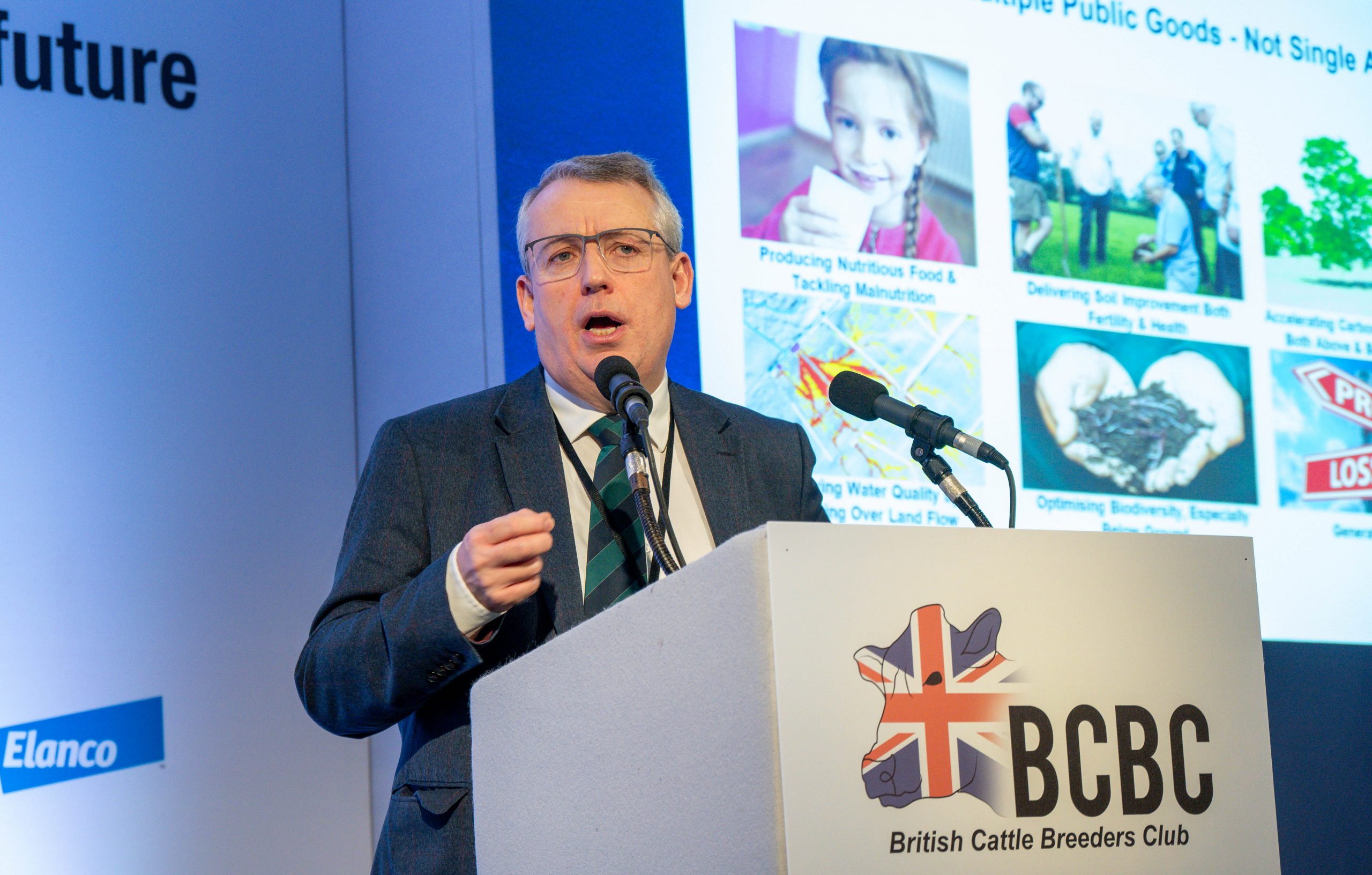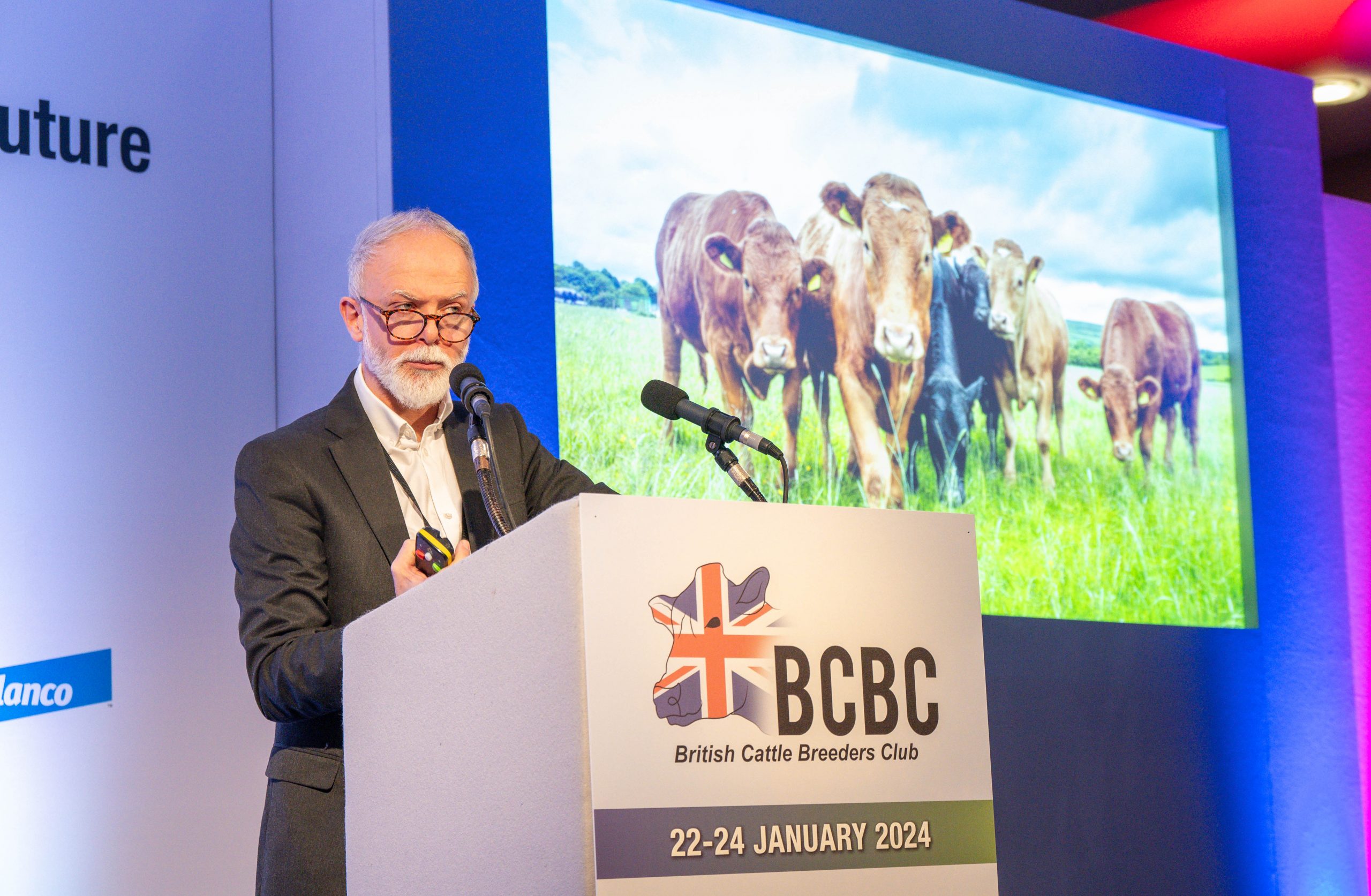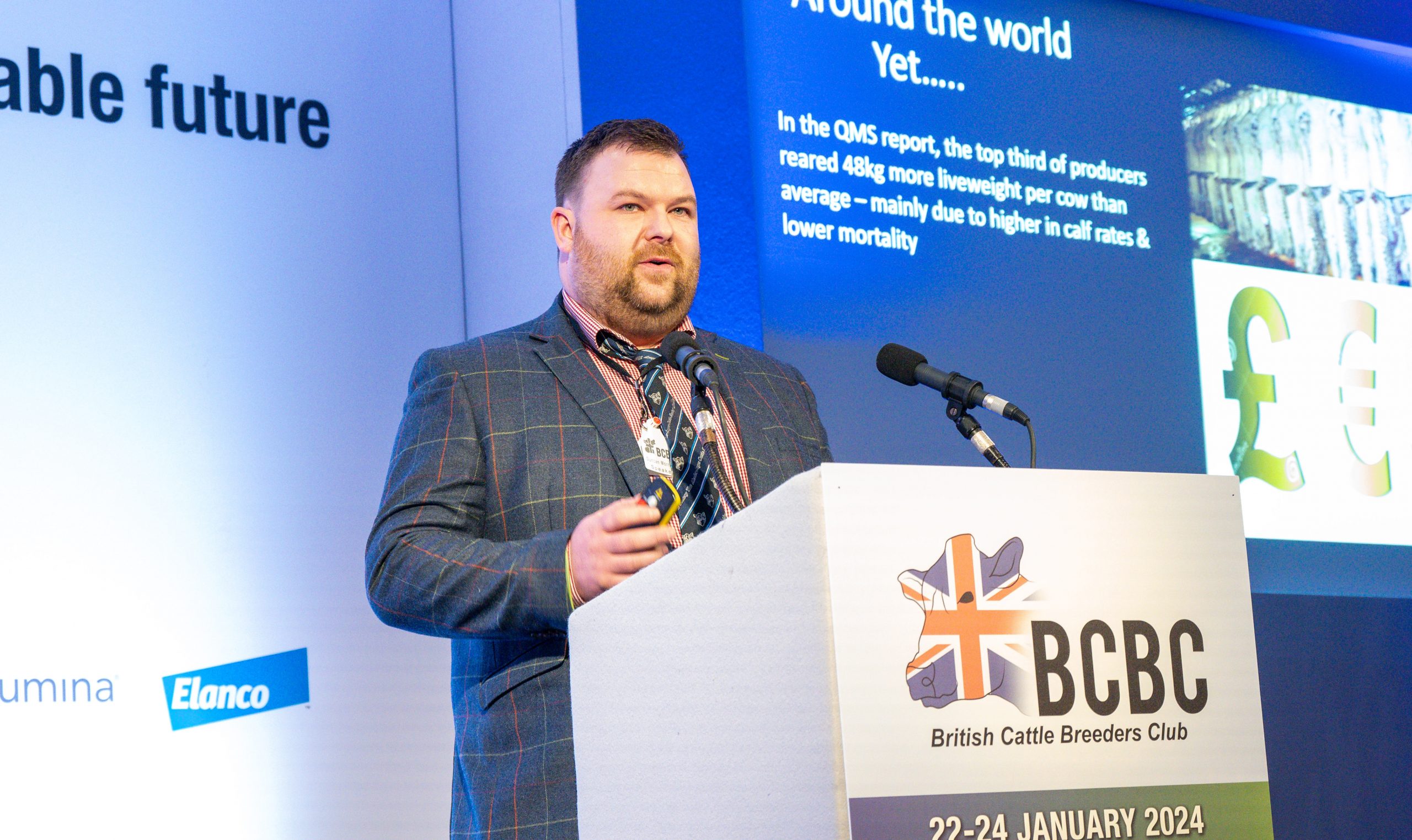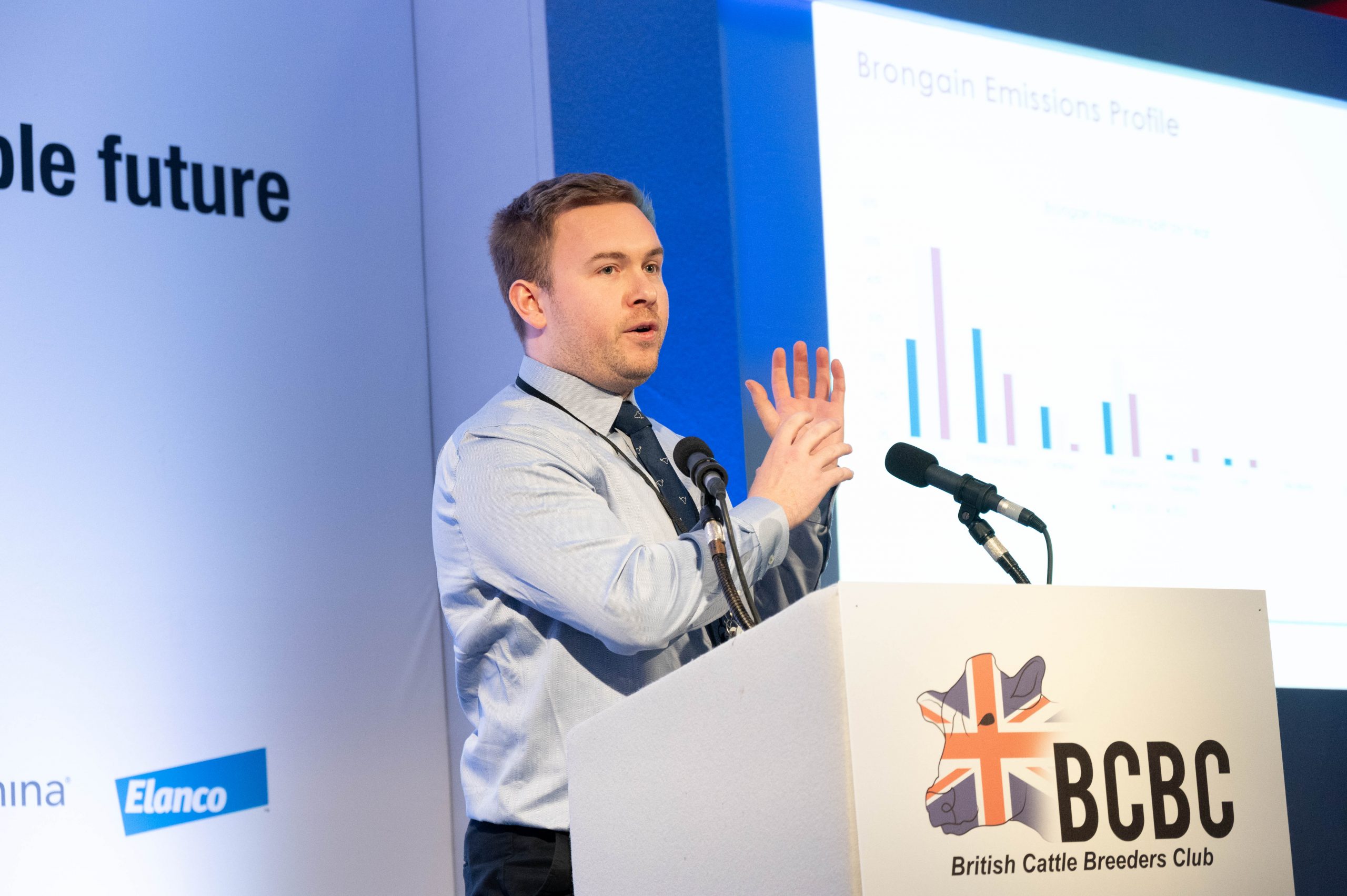
Conference sheds light on how farmers can go green
How can farmers adapt to meet the climate change challenges? This was the question posed by the British Cattle Breeders Club at its conference in Telford, Shropshire, last week (22-24 January).
Acclaimed academics, scientists and leading farmers told delegates how a combination of tools could help farmers deliver Net Zero.
These included adopting carbon calculators, using cutting-edge technology to breed more efficient animals and harnessing the untapped potential of data across the supply chain.
Beef Day delegates heard how advancements in plant breeding and the adoption of regenerative farming could also play significant roles.

Professor John Gilliland, from Queens University Belfast and AHDB adviser, presented findings from the ARC Zero project.
A journey to Net Zero
Professor John Gilliland, from Queens University Belfast and AHDB adviser, presented findings from the ARC Zero project, which involved seven farms in Northern Ireland, including his own.
As part of the project, which was funded by the NI Executive and the EU’s EIP-Agri Programme, farms measured GHG emissions and carbon sequestration. This empowered behavioural change and three farms have reached net zero since 2021 by adopting renewable energy and using multispecies, for example.
The project revealed that 97% of carbon was stored in the soil, not in trees.
Prof Gilliland said: “As we race to get rid of animals and plant trees, remember one thing: it is the soil we need to look after.”
ffinlo Costain, Chief Editor of 8point9.com and former chief executive of the think tank Farmwel, spoke about how regenerative farming was fundamental to delivering ecological security and turning the tide on the climate crisis.
He explained: “The right to affordable nutrition underpins peace and civil stability – and ‘ecological breakdown’ is already affecting the food production that depends on it.
“Just as nations are turning to renewables for greater energy security – we must turn to regenerative farming for ecological security.”
He said the grazing cow was the ‘beating heart’ of a regenerative system and the engineer that could help tie nature’s processes back together.

ffinlo Costain, Chief Editor of 8point9.com and former chief executive of the think tank Farmwel
‘Profitability underpins sustainability’
A clear message at this year’s conference was how profitability underpinned sustainability – ‘you can’t go green if you are in the red’, was how one audience member phrased it.
Aberdeenshire suckler farmer Duncan Morrison explained how running a simple, low-cost grass-based system had helped him build a ‘lean and mean’ business.
Since taking on a 226-acre tenancy in 2016, Mr Morrison has grown the business to 650 acres and will bull 250 spring-calving cows and heifers this spring – a mix of Aberdeen-Angus and Stabilisers.
He advocated investing in ‘flesh, not metal’ and performance recording animals under pressure. His replacements must be resilient – he outwinters for 125 days on bale grazing and expects animals to calve unassisted following two cycles with the bull.
He is running 160 cows/labour unit by selecting easy-calving genetics and ensuring cows have good mothering ability.
“I want cows that can stand up and be counted. A simple system with low fixed costs can be an attainable target for most farms,” he said.

Aberdeenshire suckler farmer Duncan Morrison presenting on how to run a simple, low-cost grass-based system
Collaboration and data
Delegates also heard how greater collaboration in the supply chain could help improve efficiencies.
Brongain Farm, Llanfechain, are improving daily liveweight gains and reducing days on farm by working closely with dairy farmers to select sires for calving ease and growth rate.
They are also using rapid colostrum tests and paying suppliers a 10-15% uplift for calves that achieve target.
Currently, dairy-beef animals are finished at 650kg aged 22.5 months and are at grass for 270 days, but the target is to reduce slaughter age to 20 months by improving growth rates to 1.1kg/day.
British Limousin Society Chief Executive Alice Swift echoed the importance of using data to identify where improvements could be made.
“To be efficient you need a live calf per cow per year. Over 250,000 cows in the UK don’t rear a calf to weaning. That’s massively inefficient and is a huge opportunity for us to understand why, and genetics will be playing a part in that.”
This data was based on SRUC figures which showed only 80% of the UK’s 1.3m sucklers reared a calf to weaning.
New advancements will also play a key role in the future in helping to prevent farm emissions.
Paul Billings, MD of Germinal UK and Ireland, revealed Germinal had been awarded £3.3m in Defra funding to develop clover and elite rhizobia to help fix up to 300kg of atmospheric nitrogen and eliminate the need the chemical fertilisers.
Meanwhile, Professor Sharon Huws, Director of Research at Queens University Belfast, has been exploring the effects of feeding ruminants multi-species grasses, along with seaweed and feed additives, to inhibit methane.
She said studies had shown a range in reductions but arguably one of the most promising was Red Seaweed Asparagopsis which lowered methane by 60% in beef and dairy animals.
BCBC Chairman, Ben Harman, said: “In the face of perceived challenges ahead, there was an overwhelming positivity from speakers and delegate alike.
“While it was clear that there is no silver bullet, the use of accurate data in our management and breeding decisions will help us improve our environmental and economical sustainability.”

Brongain Farm, Llanfechain, British Farming awards, Gold Winners of the Beef Farmer of the Year
The presentations will be available on talking slides site British Cattle Breeders Club (talkingslideshd.com) and are available to members and delegates.